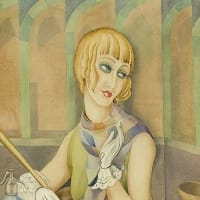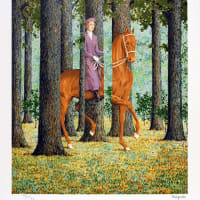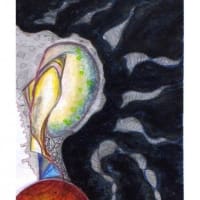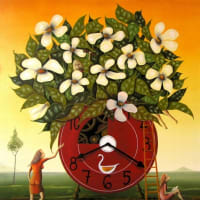In January he exhibited the Vus endormie at the Atelier de la Grosse Tour in Brussels. The critical reactions were unfavourable. The Palais des Beaux-Arts in Brussels organised a one-man exhibition of Delvaux work from 9 to 22 December. In May and June the Palais des Beaux-Arts in Brussels housed the Minotaure exhibition which included eight pictures by Giorgio de Chirico, six by Salvador Dali and five by Magritte. Delvaux was particularly interested by the Chiricos. The double and essential discovery, that of the work of Chirico and that of Surrealism, was the basis of a decisive development in Delvaux art. Shortly after visiting this exhibition, Delvaux went to stay at Spy, a small Walloon village, where he made, in June, a series of drawings and watercolours, foundations for his new aesthetic. There he painted also Femmes et pierres (Women and Stones), the only known work surviving from his stay at Spy and belonging to the E.L.T. Mesens collection. The unfriendly and desolate landscape with far-flung shadows, the classical architecture and the naked women with vacant expressions and adopting demonstrative poses foretell his essential later development. In January he painted Le paravent (The Screen) and in February Le palais en ruine (The Palace in Ruins), two pictures strongly marked by Surrealism. From 25 April to 6 May the Palais des Beaux-Arts in Brussels held an exhibition of work by Paul Delvaux and RenMagritte. Despite the influence of Surrealism on his art, Delvaux preserved his own style and chose his subject matter with a spirit of independence. He painted Le viol (The Rape), which was reproduced in the review Minotaure, no. 10 of 1937. The painting has disappeared. His father died. After the opposition shown by his parents to his relationship with Anne-Marie de Martelaere and their eventual marriage, he married Suzanne Purnal. Mesens put together the Belgian contribution to the international exhibition organised in London by the Artist International Foundation (14 April - 5 May). Delvaux formed part of the Belgian contingent with Van Assche, Brusselmans, De Smet, Magritte, Servranckx and Van den Berghe. The exhibition was put on by a congress of British artists and writers on the theme of the unity of artists in defending peace, democracy and cultural progress. He took part in the International Surrealist Exhibition organised by AndrBreton and Paul Eluard at the Galerie des Beaux-Arts in Paris (January and February). Paul Eluard dedicated the poem Exil (Exile) to Delvaux. He also took part in the International Exhibition of Surrealism held at the Robert Gallery in Amsterdam, which was organised by Kristians Tonny (March - June). From 2 June to 2 July Mesens arranged an exhibition of 17 pictures by Delvaux at the London Gallery that he ran in London. He was awarded the prize of the Acadie Picard and made his first journey to Rome and Florence. Delvaux painted Les phases de la lune (Phases of the Moon). Jules Verne Professor Lidenbrock appeared as the principal figure in the picture. He made a second journey to Italy with Paul-Aloe De Bock. Apart from Florence they included Pompeii and Herculanum in their tour. During this period antique architecture started to become increasingly important as the setting for his pictures. He took part in the International Exhibition of Surrealism organised by AndrBreton, Wolfgang Paalen and Cesar Moro at the Galeria de Arte Mexicano in Mexico. He began La ville inquie (The Anxious City) which he finished in 1941. It is one of the few pictures by Delvaux to be inspired by contemporary events. He regularly visited the Natural History Museum in Brussels where he drew skeletons. Skeletons were to feature prominently in the compositions in which studios, offices and lofts provided the setting. His picture Pygmalion was reproduced in the review Lnvention collective of February 1940.
最新の画像[もっと見る]



















